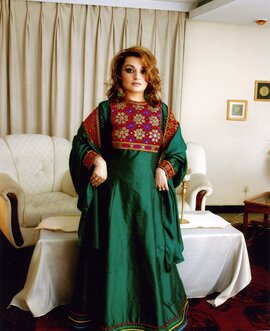“Afghan culture is under attack:” Loyola history professor brings perspective from Afghanistan

She shares her expertise in a Q&A:
How have you worked to support women in Afghanistan?
I was born in Afghanistan but left with my family as a child refugee after the Soviet invasion of Afghanistan. I was always concerned about the plight of Afghan women. In 2009, I returned to Afghanistan to teach at the American University of Afghanistan (AUAF). I helped women in several capacities. First, I led an initiative to increase female student enrollment at the university, which was disproportionate to the percentage of male students attending the university. I was able to help raise the percentage of females attending the university to 50%.
Second, I served as the director of the Women's Empowerment program at AUAF to help ensure that these female students continue their studies and graduate. I worked to help them overcome any and all challenges during their university experience. In 2015, I founded the first Gender Studies program in the history of Afghanistan. I offered the first courses in this field, which helped to create a safe space for students to not only learn but also discuss their own social challenges related to gender and gender discrimination.
I also visited the Women's Prison to speak to young girls who were incarcerated for running away from home, which is not a crime according to the Afghan constitution. However, it was dubbed a "moral crime." I worked with international human rights lawyers to advocate for these innocent girls who were resisting forced marriages and ended up in jail even though they were innocent and victims of abuse.
What have women in Afghanistan traditionally worn, and why is it important?
Women in Afghanistan have traditionally worn bright and colorful dresses accompanied by different designs from their respective regions. A great deal of embroidery and embellishments meant to reflect their place of origin are typically adorned onto these dresses. These dresses often include matching head scarves worn lightly over the head. This attire is so much more than just a piece of fashion. It is part of every Afghan woman's identity and heritage. These dresses represent their place of birth and ancestry. As such, they are part and parcel of Afghan culture. Today, as the Taliban have seized power and are attempting to transform Afghan women's clothing by mandating attire that has never been seen before in the history of Afghanistan. There is a fear that Afghan culture is under attack. Clothing is very much part of heritage and identity because it is rooted in Afghanistan's history.
How would you describe the true culture of Afghanistan?
Afghanistan is located at the confluence of four geographic zones—Central Asia, South Asia, Middle East, and Far East via a border with China. It has been called the Heart of Asia. Therefore, Afghan culture is very rich and diverse reflecting the country's distinctive geography and ethnography. As a multi-ethnic country with two official languages, Afghan culture is syncretic. It was once a major center of Buddhism. Afghanistan also had thriving Jewish, Armenian, and Sikh/Hindu communities. Due to the recent Taliban seizure of power, the last remaining Jew was forced to leave the country. So, we lost our Jewish community, which dates back centuries. Similarly, the last remaining Sikhs were evacuated to India after the Taliban took power. We feel an enormous sense of loss. Our fellow Afghan Jews and Sikhs were an integral part of Afghanistan. As a historically diverse land, Afghanistan's true culture is at odds with attempts to impose Islamic fundamentalism and extremism on the country. This is why we have seen mass protests and demonstrations recently in the country against the imposition of Taliban rule.
What are women in Afghanistan experiencing right now?
The women of Afghanistan are currently experiencing an attack on their fundamental human rights. The Taliban have banned girls from going to school and women from working. This makes Afghanistan the only country in the world where girls are prohibited from becoming educated. The Taliban government is made up of U.S.-designated terrorists. Afghan women are also facing a humanitarian crisis. It is important to point out that the women of Afghanistan must not be abandoned because what is happening in the country is a struggle for humanity and this cannot be just Afghanistan's fight. It is incumbent upon the international community to put pressure on the Taliban and their sponsors in Pakistan to respect the human rights of Afghan citizens.
How can Americans help women in Afghanistan?
Americans should put pressure on the U.S. government to not recognize the Taliban as the legitimate government of Afghanistan. The Taliban came to power by force. What is happening in Afghanistan is actually a Pakistani invasion through the Taliban, which is a proxy force. In this context, Afghan sovereignty, identity, culture, and heritage are all under assault. What is happening in Afghanistan is not a civil conflict. It is an invasion by a neighboring country that has long harbored a desire to make Afghanistan a client state. Americans should put pressure on the Taliban to respect women's rights. Humanitarian assistance should be provided to Afghans. Americans can also help by raising awareness about the plight of Afghan women through their social media platforms and writing to their elected officials. Afghan women are in dire need of all kinds of assistance from the international community—big and small.